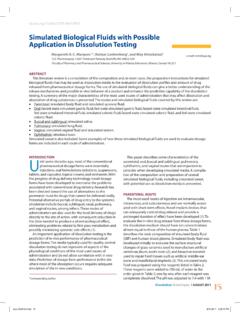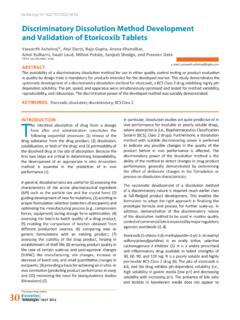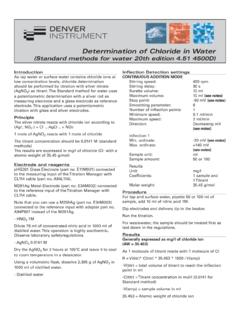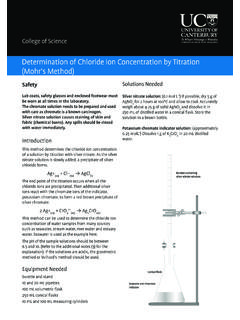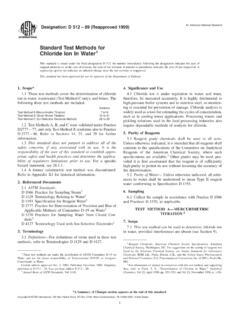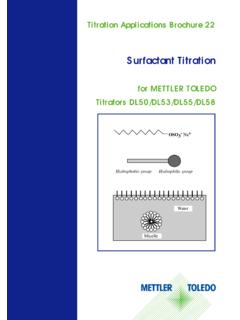Transcription of Determination of Thermodynamic Solubility of Active ...
1 36 FEBRUARY 2017 INTRODUCTIONThe United States Pharmacopeia (USP) held the workshop Solubility Criteria for Veterinary Products on November 7 8, 2012, at USP headquarters (1). One of the workshop outcomes was a decision by participants that the content of the new general chapter would focus on species-appropriate descriptions of conditions for testing in vitro drug the Solubility of drug candidates is important in pharmaceutical research, both for the discovery phase and the development phase (2, 3). In the early stages of drug research, Solubility together with other physicochemical parameters (lipophilicity, ionization, and permeability) is used to screen drug candidates. This information is needed to support formulation development, including product optimization and salt selection.
2 During the later phases of product development, Solubility considerations are useful in planning for challenges that may be encountered when addressing formulation modifications and the associated bioequivalence issues. BACKGROUND In the pharmaceutical literature, two commonly used Solubility terms are: (1) kinetic Solubility , the concentration of a compound at the time when an induced precipitate first appears in the solution; and (2) equilibrium (or Thermodynamic ) Solubility , the concentration of a compound in a saturated solution when an excess of solid is present, and the solution and solid are at equilibrium. A third term, intrinsic Solubility , refers to the equilibrium Solubility of the free acid or base form of an ionizable compound at a pH where it is fully un-ionized (2).
3 Aqueous equilibrium Solubility is the partitioning of a compound between its pure phase and water. At equilibrium, there is a dynamic, balanced process of dissolution of the solid into solution and recrystallization of the drug from solution. The molar aqueous Solubility (SW) can be empirically correlated to activity and crystal lattice energy via the general Solubility equation (GSE) proposed by Yalkowsky (4, 5): log SW = (MP 25) log KOW + = melting point KOW = octanol water partition coefficient Determination of Thermodynamic Solubility : 2015 United States Pharmacopeial Convention. Used with TO THE REVISION PROCESS Stimuli articles do not necessarily reflect the policies of the USPC or the USP Council Experts Determination of Thermodynamic Solubility of Active Pharmaceutical Ingredients for Veterinary Species: A New USP General Chapter Mike Apley1, G.
4 Bryan Crist1, Vivek Fellner2, Mario A. Gonzalez1,3, Robert P. Hunter1, Marilyn N. Martinez1, Janis R. Messenheimer1, Sanja Modric1, Mark G. Papich1, Alan F. Parr1,3, Jim E. Riviere1, Margareth R. C. Marques4,*1 USP Solubility Criteria for Veterinary Products Expert Panel. 2 Dept. of Animal Science, North Carolina State University. 3 USP Dosage Forms Expert Committee. 4 Principal Scientific Liaison, USPABSTRACTThis Stimuli article discusses the approach for the development of a new general chapter on Solubility Determination for veterinary drug products. Possible procedures are discussed, with emphasis on the shake-flask method. Recommendations are included on the test conditions for products to treat dogs and cattle. The Expert Panel welcomes comments from the public and : *Correspondence should be addressed to Margareth R.
5 C. Marques, , Principal Scientific Liaison, USP, e-mail: phone 301-816-8106. 37 FEBRUARY 2017 There are multiple computational tools for prediction of aqueous Solubility including ACD Labs, COSMO RS, QikPro, and others (6). As a physicochemical property, Solubility is influenced by: temperature; pressure; purity of materials; composition of buffer solutions and properties of the compound, such as polymorphism; aggregation; and the formation of supersaturated solutions. The effect of pH on the Solubility of ionizable compounds is a well-known and an extensively examined phenomenon (2, 7). For poorly soluble compounds, determining the Solubility in the presence of various solubilizing agents presents a special set of challenges (7). When Solubility is measured, the value obtained is also influenced by several experimental factors, including: stirring time, sedimentation time, composition of the aqueous buffer, temperature, amount of solid excess, and the technique used for phase-separation (2).
6 EXPERIMENTAL METHODS Saturation Shake-Flask MethodThe shake-flask method is based on the phase Solubility technique that was developed 40 years ago and is still considered by most to be the most reliable and widely used method for Solubility measurement today (2, 3, 8 10). The sample is typically prepared by adding an excess of solid to the Solubility medium, which is in a stoppered flask or vial. The amount of medium in the flask or vial does not need to be measured accurately. Although it is important to ensure that the amount of added material is sufficient to produce a suspension, it is also important to avoid adding an amount of material that will significantly alter the properties of the Solubility medium, including its pH (7, 8). The pH of the suspension should be verified after the addition of the compound and at the end of the experiment (3).
7 It is generally agreed that saturation or equilibrium has been reached when multiple samples, assayed after different equilibration time periods, yield the same result for apparent Solubility . The time to reach equilibrium can vary as a function of the type of agitation used, the Active ingredient properties, the amount of material used, and the equilibration method used. With an agitation rate that is adequate to prevent particle agglomeration and to ensure particle contact with the diluent, samples generally reach equilibrium quickly (often within 24 h). However, for poorly soluble compounds, the equilibrium time may be prolonged, well beyond 24 h, because of a poor dissolution rate that is further depressed as the equilibrium process advances and the concentration in solution gets closer to the limit of drug Solubility .
8 One way to expedite the process is to increase the effective surface area for dissolution. This can be achieved by either vortexing or sonicating the samples prior to equilibrium evaluation. Other challenges in determining the Solubility of poorly soluble compounds are their poor wettability and their tendency to float. Potential remedies include the use of small glass microspheres to de-aggregate the particles with agitation or sonication, or adding a quantity of surfactant that is below the critical micelle concentration to serve as a wetting agent. If the addition of surfactant causes too much foaming, a small amount (just 1 or 2 drops) of an appropriate defoaming agent, such as n-octanol, can be added. Filtration and centrifugation are both commonly used to separate the saturated solution from the solute phase.
9 However, filter sorption can be a significant source of error. Generally, filter sorption is most critical for hydrophobic and poorly soluble compounds, and as expected filter sorption is directly proportional to filter surface area (7). High performance liquid chromatography (HPLC) is the most commonly used analytical tool for the analysis of saturated solutions. The advantage of HPLC over the spectrophotometric method is that HPLC can detect impurities and any instability (7, 8). pH Solubility ProfileFor drugs with ionizable functional groups, determining Solubility as a function of pH is very important. Typically, there are two ways to control pH. One approach is to use buffers. Because multiple buffer systems are needed to control the entire pH range, the Solubility results may be complicated by salt formation with the buffer species.
10 This can be detected by examining the residual solid from Solubility determinations. Another way to control pH is through the use of a pH-stat, where pH is controlled by titrating with acidic and/or basic solutions. Ionic equilibrium can be monitored continuously by measuring the solution pH. Equilibrium has been reached, it is generally assumed, when the pH no longer changes over a period of time. Solubility of SaltsUse of the equilibrium method for determining the Solubility of pharmaceutical salts may be challenging for certain compounds, such as those with poor intrinsic Solubility . Theoretically, after an excess amount of solid 38 FEBRUARY 2017salt is equilibrated in water, the solution concentration at equilibrium should represent the Solubility of the salt.




